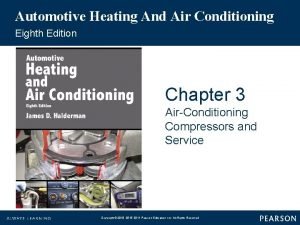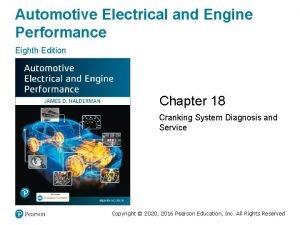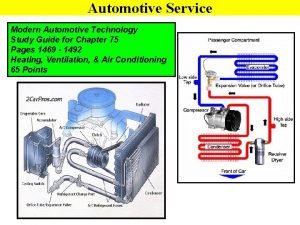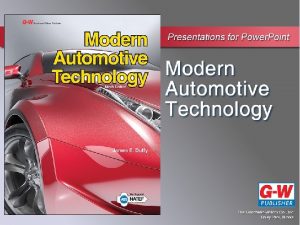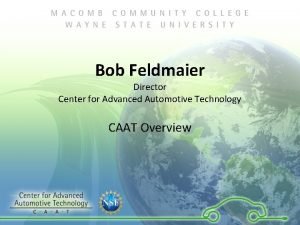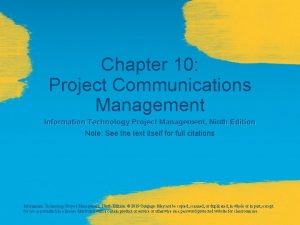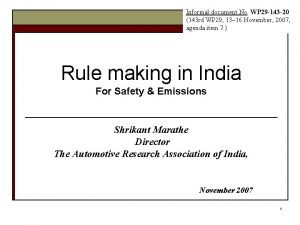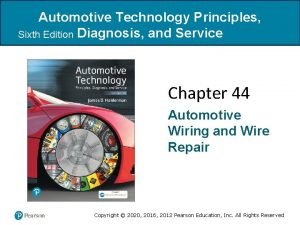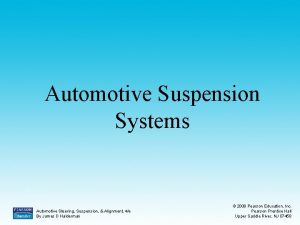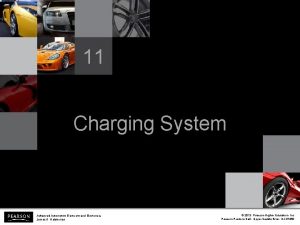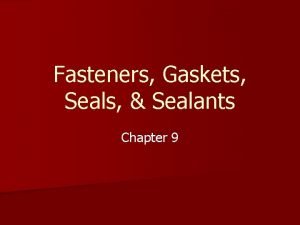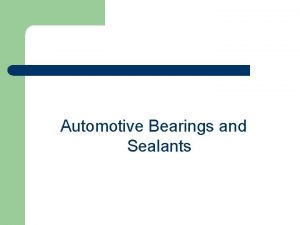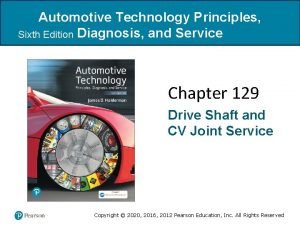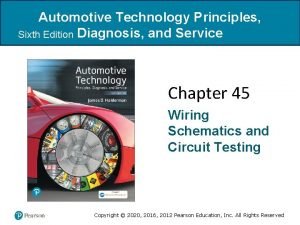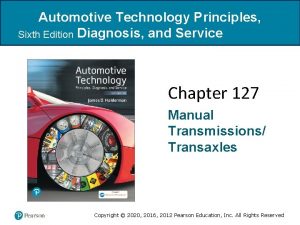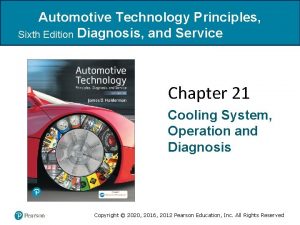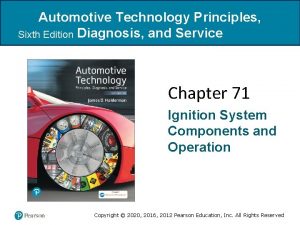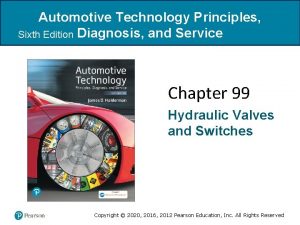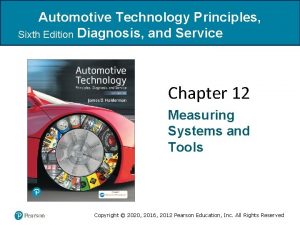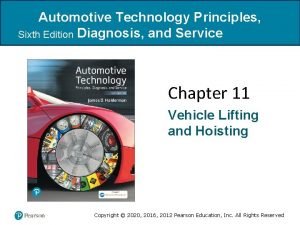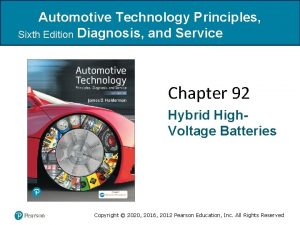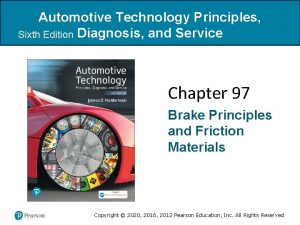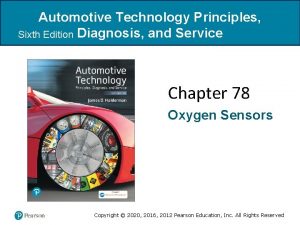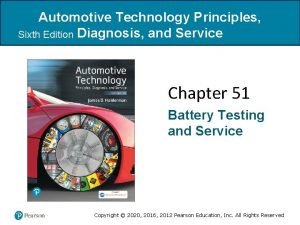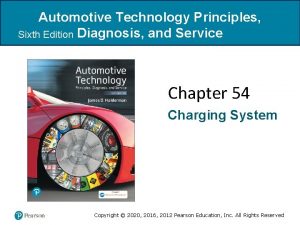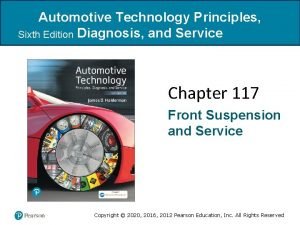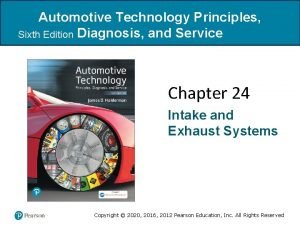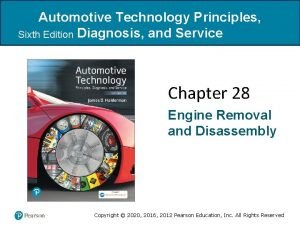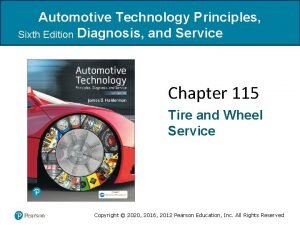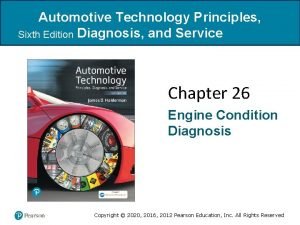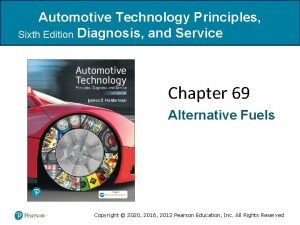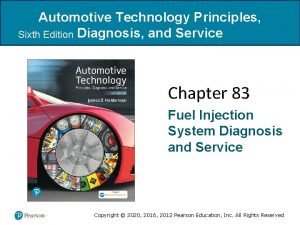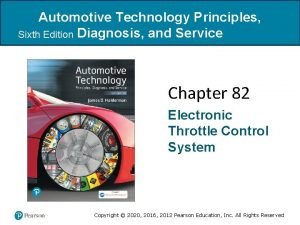Automotive Technology Principles Sixth Edition Diagnosis and Service



























































- Slides: 59

Automotive Technology Principles, Sixth Edition Diagnosis, and Service Chapter 44 Automotive Wiring and Wire Repair Copyright © 2018, 2015, 2011 Pearson Education, Inc. All Rights Reserved Copyright © 2020, 2016, 2012 Pearson Education, Inc. All Rights Reserved

LEARNING OBJECTIVES (1 of 2) 44. 1 Explain automotive wiring and wire gauge systems. 44. 2 Explain the purpose of ground wires, battery cables, and jumper cables. 44. 3 Describe how fuses, fusible links, circuit breakers, and PTC circuit protector protect circuits and wiring. Copyright © 2020, 2016, 2012 Pearson Education, Inc. All Rights Reserved

LEARNING OBJECTIVES (2 of 2) 44. 4 List the steps for removing a terminal from a connector. 44. 5 List the steps for performing each method of wire repair. 44. 6 Explain the types of electrical conduit. Copyright © 2020, 2016, 2012 Pearson Education, Inc. All Rights Reserved

AUTOMOTIVE WIRING • Definition and Terminology – Most automotive wire is made from strands of copper covered by plastic insulation. • American Wire Gauge (AWG) – As the gauge number increases, the size of the conductor wire decreases. • Metric Wire Gauge – Sizes measured in square millimeters (mm ) of crosssectional area. 2 Copyright © 2020, 2016, 2012 Pearson Education, Inc. All Rights Reserved

Chart 44 -1 The list of relative conductivity of metals, showing silver to be the best. Copyright © 2020, 2016, 2012 Pearson Education, Inc. All Rights Reserved

Chart 44 -2 American wire gauge (AWG) number and the actual conductor diameter in inches. Copyright © 2020, 2016, 2012 Pearson Education, Inc. All Rights Reserved

Chart 44 -3 Metric wire size in square millimeters (mm 2) conversion chart to American wire gauge (AWG). Copyright © 2020, 2016, 2012 Pearson Education, Inc. All Rights Reserved

Chart 44 -4 Recommended AWG wire size increases as the length increases because all wires have internal resistance. The longer the wire is, the greater the resistance. The larger the diameter is, the lower the resistance. Copyright © 2020, 2016, 2012 Pearson Education, Inc. All Rights Reserved

QUESTION 1: ? What is the difference between the American wire gauge (AWG) system and the metric system? Copyright © 2020, 2016, 2012 Pearson Education, Inc. All Rights Reserved

ANSWER 1: The method that the wire is sized. Copyright © 2020, 2016, 2012 Pearson Education, Inc. All Rights Reserved

GROUND WIRES • Purpose and Function – All vehicles use ground wires between the engine and body and/or between the body and the negative terminal of the battery. • Skin Effect – The skin effect is the term used to describe how highfrequency AC electricity flows through a conductor. Copyright © 2020, 2016, 2012 Pearson Education, Inc. All Rights Reserved

Figure 44. 1 All lights and accessories ground to the body of the vehicle. Copyright © 2020, 2016, 2012 Pearson Education, Inc. All Rights Reserved

FREQUENTLY ASKED QUESTION Copyright © 2020, 2016, 2012 Pearson Education, Inc. All Rights Reserved

BATTERY CABLES • Battery cables are the largest wires used in the automotive electrical system. The cables are usually 4 -gauge, 2 -gauge, or 1 -gauge wires (19 mm 2 or larger). Copyright © 2020, 2016, 2012 Pearson Education, Inc. All Rights Reserved

Figure 44. 2 Battery cables are designed to carry heavy starter current and are, therefore, usually 4 gauge or larger wire. Copyright © 2020, 2016, 2012 Pearson Education, Inc. All Rights Reserved

JUMPER CABLES • Jumper cables are 4 - to 2/0 -gauge electrical cables with large clamps attached, and are used to connect the discharged battery of one vehicle to the good battery of another vehicle. • 1/0 AWG welding cable can be used to construct an excellent set of jumper cables using welding clamps on both ends. Copyright © 2020, 2016, 2012 Pearson Education, Inc. All Rights Reserved

FUSES AND CIRCUIT PROTECTION DEVICES (1 OF 5) • Construction – A fuse is constructed of a fine tin conductor inside a glass, plastic, or ceramic housing. • Fuse Ratings – The fuse rating is normally about 20% higher than the normal current in the circuit. • Blade Fuses – Colored blade-type fuses are also referred to as ATO fuses and have been used since 1977. Copyright © 2020, 2016, 2012 Pearson Education, Inc. All Rights Reserved

FUSES AND CIRCUIT PROTECTION DEVICES (2 OF 5) • Mini Fuses – To save space, many vehicles use mini (small) blade fuses. • Maxi Fuses – Maxi fuses are a large version of blade fuses and are used to replace fusible links in many vehicles. • Pacific Fuse Element – First used in the late 1980 s, Pacific fuse elements (also called a fuse link or auto link) are used to protect wiring from a direct short-to-ground. Copyright © 2020, 2016, 2012 Pearson Education, Inc. All Rights Reserved

FUSES AND CIRCUIT PROTECTION DEVICES (3 OF 5) • Testing Fuses – All fuses should be tested with a test light. • Circuit Breakers – Circuit breakers are mechanical units made of two different metals (bimetallic) that deform when heated, and open a set of contact points that work in the same manner as an “off” switch. • PTC Circuit Protectors – Positive temperature coefficient circuit protectors are solid-state (without moving parts). Copyright © 2020, 2016, 2012 Pearson Education, Inc. All Rights Reserved

FUSES AND CIRCUIT PROTECTION DEVICES (4 OF 5) • Fusible Links – A fusible link is a type of fuse that consists of a short length (6 to 9 inches long) of standard copper-strand wire covered with a special nonflammable insulation. • Mega Fuse – Many newer vehicles are equipped with mega fuses instead of fusible links to protect high-amperage circuits. Copyright © 2020, 2016, 2012 Pearson Education, Inc. All Rights Reserved

FUSES AND CIRCUIT PROTECTION DEVICES (5 OF 5) • Checking Fusible Links and Mega Fuses – To check a fusible link, gently pull on each end to see if it stretches. – Check a Mega fuse with a test light. • Replacing a Fusible Link – Check service information for the exact length, gauge, and type of fusible link required. – Replace the fusible link with the specified fusible link wire and according to the instructions found in the service information. Copyright © 2020, 2016, 2012 Pearson Education, Inc. All Rights Reserved

Chart 44 -5 The fuse rating should be 20% higher than the maximum current in the circuit to provide the best protection for the wiring and the component being protected. Copyright © 2020, 2016, 2012 Pearson Education, Inc. All Rights Reserved

Figure 44. 3 A typical Underhood Electrical Center (UHEC). Most are referred to as an “intelligent power distribution box” or a “smart junction box, ” because underneath (lower figure) are wires that join the circuits from the maxi fuses to other fuses and to or from relays. Copyright © 2020, 2016, 2012 Pearson Education, Inc. All Rights Reserved

Chart 44 -6 The amperage rating and the color of the blade fuse are standardized. Copyright © 2020, 2016, 2012 Pearson Education, Inc. All Rights Reserved

Figure 44. 4 Blade-type fuses can be tested through openings in the plastic at the top of the fuse Copyright © 2020, 2016, 2012 Pearson Education, Inc. All Rights Reserved

Chart 44 -7 Mini fuse amperage rating and colors. Copyright © 2020, 2016, 2012 Pearson Education, Inc. All Rights Reserved

Chart 44 -8 Maxi fuse amperage rating and colors. Copyright © 2020, 2016, 2012 Pearson Education, Inc. All Rights Reserved

Figure 44. 5 Three sizes of blade-type fuses: mini on the left, standard or ATO type in the center, and maxi on the right Copyright © 2020, 2016, 2012 Pearson Education, Inc. All Rights Reserved

Figure 44. 6 A comparison of the various types of protective devices used in most vehicles Copyright © 2020, 2016, 2012 Pearson Education, Inc. All Rights Reserved

Figure 44. 7 To test a fuse, use a test light to check for power at the power side of the fuse. Copyright © 2020, 2016, 2012 Pearson Education, Inc. All Rights Reserved

Figure 44. 8 Typical blade circuit breaker fits into the same space as a blade fuse. Copyright © 2020, 2016, 2012 Pearson Education, Inc. All Rights Reserved

Figure 44. 9 Electrical symbols used to represent circuit breakers Copyright © 2020, 2016, 2012 Pearson Education, Inc. All Rights Reserved

Figure 44. 10 (a) With normal current flow, the temperature of the PTC circuit protector remains normal. (b) When current exceeds the amperage rating of the PTC circuit protector, the polymer material that makes up the electronic circuit protector increases in resistance. Copyright © 2020, 2016, 2012 Pearson Education, Inc. All Rights Reserved

Figure 44. 11 PTC circuit protectors are used extensively in the power distribution center of this Chrysler vehicle Copyright © 2020, 2016, 2012 Pearson Education, Inc. All Rights Reserved

Figure 44. 12 Fusible links are usually located close to the battery and are usually attached to a junction block. Copyright © 2020, 2016, 2012 Pearson Education, Inc. All Rights Reserved

Figure 44. 13 Several maxi fuses are used on this Chevrolet to protect all the circuits, including the 300 A fuse that is connected directly to the positive battery cable Copyright © 2020, 2016, 2012 Pearson Education, Inc. All Rights Reserved

QUESTION 2: ? How do fuses, PTC circuit protectors, circuit breakers, and fusible links protect a circuit? Copyright © 2020, 2016, 2012 Pearson Education, Inc. All Rights Reserved

ANSWER 2: The tin is designed to melt and open the circuit if excessive current flows through the fuse. Copyright © 2020, 2016, 2012 Pearson Education, Inc. All Rights Reserved

TERMINALS AND CONNECTORS • A terminal is a metal fastener attached to the end of a wire, which makes the electrical connection. • The term connector usually refers to the plastic portion that snaps or connects together, making the mechanical connection. Copyright © 2020, 2016, 2012 Pearson Education, Inc. All Rights Reserved

Figure 44. 14 Some terminals have seals attached to help seal the electrical connections Copyright © 2020, 2016, 2012 Pearson Education, Inc. All Rights Reserved

Figure 44. 15 Separate a connector by opening the lock and pulling the two apart Copyright © 2020, 2016, 2012 Pearson Education, Inc. All Rights Reserved

Figure 44. 16 The secondary locks help retain the terminals in the connector Copyright © 2020, 2016, 2012 Pearson Education, Inc. All Rights Reserved

Figure 44. 17 Use a small removal tool, sometimes called a pick, to release terminals from the connector Copyright © 2020, 2016, 2012 Pearson Education, Inc. All Rights Reserved

WIRE REPAIR (1 OF 2) • Solder – Solder is an alloy of tin and lead used to make a good electrical contact between two wires or connections in an electrical circuit. • Crimping Terminals – Terminals can be crimped to create a good electrical connection if the proper type of crimping tool is used. . Copyright © 2020, 2016, 2012 Pearson Education, Inc. All Rights Reserved

WIRE REPAIR (2 OF 2) • Crimp and Seal Connectors – Crimp-and-seal connectors contain a sealant and shrink tubing in one piece and are not simply butt connectors. • Aluminum Wire Repair – If any aluminum wire must be repaired or replaced, the manufacturer specific procedure should be used to be assured of a proper repair. Copyright © 2020, 2016, 2012 Pearson Education, Inc. All Rights Reserved

Figure 44. 18 Always use rosin-core solder for electrical or electronic soldering. Also, use small-diameter solder for small soldering irons. Copyright © 2020, 2016, 2012 Pearson Education, Inc. All Rights Reserved

Figure 44. 19 A butane-powered soldering tool. The cap has a built-in striker to light a converter in the tip of the tool. Copyright © 2020, 2016, 2012 Pearson Education, Inc. All Rights Reserved

Figure 44. 20 Notice that to create a good crimp the open part of the terminal is placed in the jaws of the crimping tool toward the anvil or the W-shape part Copyright © 2020, 2016, 2012 Pearson Education, Inc. All Rights Reserved

Figure 44. 21 All hand-crimped splices or terminals should be soldered to be assured of a good electrical connection Copyright © 2020, 2016, 2012 Pearson Education, Inc. All Rights Reserved

Figure 44. 22 A butane torch especially designed for use on heat shrink applies heat without an open flame, which could cause damage Copyright © 2020, 2016, 2012 Pearson Education, Inc. All Rights Reserved

Figure 44. 23 A typical crimp-and-seal connector. This type of connector is first lightly crimped to retain the ends of the wires and then it is heated. Copyright © 2020, 2016, 2012 Pearson Education, Inc. All Rights Reserved

Figure 44. 24 Heating the crimp-and-seal connector melts the glue and forms an effective seal against moisture Copyright © 2020, 2016, 2012 Pearson Education, Inc. All Rights Reserved

QUESTION 3: ? How should a wire repair be done if the repair is under the hood where it is exposed to the outside? Copyright © 2020, 2016, 2012 Pearson Education, Inc. All Rights Reserved

ANSWER 3: Vehicle manufacturers recommend all wire repairs performed under the hood, or where the repair could be exposed to the elements, be weatherproof. Copyright © 2020, 2016, 2012 Pearson Education, Inc. All Rights Reserved

ELECTRICAL CONDUIT • Black Conduit with Green or Blue Stripe – This conduit is designed for high temperatures and is used under the hood and near hot engine parts. • Blue or Yellow Conduit – This color conduit is used to cover wires that have voltages ranging from 12 to 42 volts. • Orange Conduit – This color conduit is used to cover wiring that carries high-voltage current above 60 volts. Copyright © 2020, 2016, 2012 Pearson Education, Inc. All Rights Reserved

Figure 44. 25 Conduit that has a paint stripe is constructed of plastic that can withstand high underhood temperatures Copyright © 2020, 2016, 2012 Pearson Education, Inc. All Rights Reserved

Figure 44. 26 (a) Blue conduit is used to cover circuits that carry up to 42 volts. (b) Yellow conduit can also be used to cover 42 -volt wiring Copyright © 2020, 2016, 2012 Pearson Education, Inc. All Rights Reserved

Figure 44. 27 Always follow the vehicle manufacturer’s instructions, which include the use of linesman’s (high-voltage) gloves, if working on circuits that are covered in orange conduit Copyright © 2020, 2016, 2012 Pearson Education, Inc. All Rights Reserved

Copyright © 2020, 2016, 2012 Pearson Education, Inc. All Rights Reserved
 Automotive technology sixth edition
Automotive technology sixth edition Automotive technology sixth edition
Automotive technology sixth edition Principles of economics sixth edition
Principles of economics sixth edition The sixth sheik's sixth sheep's sick
The sixth sheik's sixth sheep's sick The sixth sick sheik's sixth sheep's sick lyrics
The sixth sick sheik's sixth sheep's sick lyrics Automotive heating and air conditioning 8th edition
Automotive heating and air conditioning 8th edition Biochemistry sixth edition 2007 w.h. freeman and company
Biochemistry sixth edition 2007 w.h. freeman and company Automotive engines 8th edition
Automotive engines 8th edition China automotive technology and research center
China automotive technology and research center Computer architecture a quantitative approach sixth edition
Computer architecture a quantitative approach sixth edition Apa sixth edition
Apa sixth edition Computer architecture a quantitative approach sixth edition
Computer architecture a quantitative approach sixth edition Precalculus sixth edition
Precalculus sixth edition Computer architecture a quantitative approach sixth edition
Computer architecture a quantitative approach sixth edition Nursing process assessment
Nursing process assessment Medical diagnosis and nursing diagnosis difference
Medical diagnosis and nursing diagnosis difference Types of nursing diagnosis
Types of nursing diagnosis Nursing process and critical thinking
Nursing process and critical thinking Modern automotive technology answer key
Modern automotive technology answer key Automotive technology chapter 51 answers
Automotive technology chapter 51 answers Structural mechanics exam questions
Structural mechanics exam questions Bob caat
Bob caat Automotive grade 10
Automotive grade 10 Sixth sense technology seminar report
Sixth sense technology seminar report Sixth sense technology seminar
Sixth sense technology seminar Ted sixth sense
Ted sixth sense Perbedaan diagnosis gizi dan diagnosis medis
Perbedaan diagnosis gizi dan diagnosis medis Brake system diagnosis and repair
Brake system diagnosis and repair Using mis (10th edition) 10th edition
Using mis (10th edition) 10th edition Using mis (10th edition)
Using mis (10th edition) Computer security principles and practice
Computer security principles and practice Computer security principles and practice 4th edition
Computer security principles and practice 4th edition Expert systems: principles and programming, fourth edition
Expert systems: principles and programming, fourth edition Kasavana and smith matrix
Kasavana and smith matrix Food and beverage management book pdf
Food and beverage management book pdf New wave brasserie (gastrodome)
New wave brasserie (gastrodome) Food and beverage service' 9 th edition
Food and beverage service' 9 th edition Food and beverage service sequence
Food and beverage service sequence Qqq tea
Qqq tea Information technology project management 9th edition
Information technology project management 9th edition Blue project chapter 5
Blue project chapter 5 Ethics in information technology fourth edition
Ethics in information technology fourth edition Ethics in information technology fourth edition
Ethics in information technology fourth edition Information technology project management 8th edition
Information technology project management 8th edition Information technology project management 9th edition
Information technology project management 9th edition Basic environmental technology
Basic environmental technology Information technology project management 9th edition
Information technology project management 9th edition Automotive regulations and standards
Automotive regulations and standards Chapter 44 automotive wiring and wire repair
Chapter 44 automotive wiring and wire repair Halderman
Halderman Advanced automotive electric
Advanced automotive electric Chapter 2 automotive careers and ase certification
Chapter 2 automotive careers and ase certification Auto upkeep answer key
Auto upkeep answer key Fasteners gaskets seals and sealants
Fasteners gaskets seals and sealants Fasteners gaskets seals and sealants
Fasteners gaskets seals and sealants Automotive bearings and seals
Automotive bearings and seals Failure of supporting utilities and structural collapse
Failure of supporting utilities and structural collapse Principles of electronic communication systems 3rd edition
Principles of electronic communication systems 3rd edition Principle of economics third edition
Principle of economics third edition Accounting principles second canadian edition
Accounting principles second canadian edition





